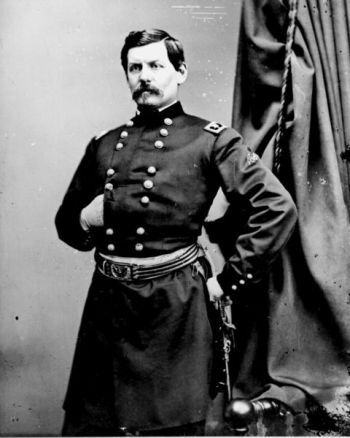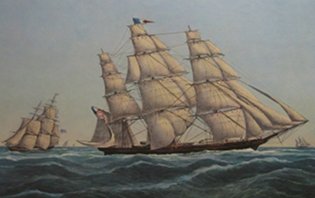Thursday, April 24. 2008
Photo: Maj. Gen. George B. McClellan  Peacetime Generals: Too Fearful of Losing to Risk Winning Peacetime Generals: Too Fearful of Losing to Risk Winning
Peacetime generals have never been able to fight wars. President Abraham Lincoln’s peacetime general was George Brinton McClellan. According to Wikipedia, “Although he understood that the Confederacy had to be defeated, McClellan, a member of the Democrat Party, advocated military conduct under “the highest principles known to Christian civilization” and was generally conservative on slavery. Hence, he was never in favor with Radical Republicans, who demanded the immediate abolition of slavery and regarded McClellan as “soft” on military measures. McClellan's supposed moderation became a central issue when he ran for president in 1864. Although he strongly advocated continuing the war until victory was achieved, some historians have suggested that if McClellan had defeated the Republican Lincoln, the peace faction within the Democratic Party would have insisted that the war effort be suspended, and the Confederacy would thereby have achieved independence.”
The Reader's Companion to American History adds: “A month into the Civil War McClellan was appointed major general in the Regular Army and commander of the Department of the Ohio. After efficiently managing a campaign in western Virginia, he was summoned to Washington late in July 1861, following the Bull Run debacle, to take command of the main Union army in the East. Over the next eight months he trained and organized the Army of the Potomac, serving for four of those months as general-in-chief of all the Union armies. “In April 1862 McClellan took the field to direct the largest campaign of the war, an advance against Richmond via the Virginia peninsula. For three months he inched his way cautiously toward the Confederate capital, but in the Seven Days' Battles (June 25-July 1) he was driven into retreat by Robert E. Lee's smaller Army of Northern Virginia. Ordered to evacuate the peninsula in August, McClellan was slow to send reinforcements to the embattled Union forces at Second Bull Run, and Lee was again victorious. When the Confederate army invaded Maryland early in September, President Abraham Lincoln reluctantly turned once again to McClellan, a general stained by defeat but the only general capable of restoring shattered Union morale. On September 17, along Antietam Creek near Sharpsburg, McClellan finally brought Lee to battle. Despite his greatly superior force, McClellan's cautious generalship gained only a draw in the bloodiest single day's fighting of the war. He refused to pursue Lee back into Virginia and was reluctant to renew the campaign in the weeks that followed. On November 5, 1862, Lincoln ordered him relieved of command. . . . He was a general afflicted with "the slows" (as Lincoln put it), too fearful of losing to risk winning.”
Every president since Lincoln has had serious problems with peacetime generals in the opening years of a war. It is not hard to understand. The peacetime military is civil service with dazzling uniforms, and the skill-set needed and used to get that all-important promotion from Colonel to General, or Captain to Admiral, is the antithesis of the skill-set needed to win battles. The warfighter must be a risk-taker, an innovator, and a swift decision-maker. The “Perfumed Pentagon Prince” to succeed in the Pentagon must be compliant, doctrinaire, and collaborative. Generals Colin Powell, the media Saint, and Norman Schwarzkopf in the first Iraq war were pushed by SECDEF Cheney to listen to Colonel John Boyd (see “BOYD, The Fighter Pilot Who Changed the Art of War”) who devised the famous “Left Hook” that cut off and isolated the Republican Guard. Generals Powell and Schwarzkopf wanted to follow the “Powell Doctrine” which called for a deliberate massive push “up the center” with overwhelming force, the tactic developed for opposing Soviet tanks in Eastern Europe, but they were overruled by Cheney, and Stormin’ Norman was gracefully given credit for the wildly successful “Hail Mary” attack. President Clinton had similar problems. Pentagon brass refused to attack Al Qaeda on the grounds that it was not a “country” and they couldn’t attack private individuals. Former White House counterterrorism chief Richard Clarke in his book “Against All Enemies: Inside America’s War on Terror”, quotes Mike Sheehan, a State Department official, saying in frustration, “What’s it going to take, Dick? Who the shit do they think attacked the [USS] Cole, fuckin’ Martians? The Pentagon brass won’t let Delta go get bin Laden. Hell they won’t even let the Air Force carpet bomb the place. Does al Qaeda have to attack the Pentagon to get their attention?” We know they did, and it did, but that came later. Further, according to Dana Priest's book “The Mission”, the Clinton White House wanted U.S. pilots in the no-fly zone to provoke the Iraqis into attacking American planes. The then-CENTCOM commander, General Anthony Zinni, believed that this could lead to war with Iraq and insisted that the White House issue him a direct order to undertake such an action. Faced with leaving a paper trail, the White House changed its mind.
In 2003, peacetime Secretary of Defense Rumsfeld, seeing that following the Powell Doctrine would have been a poor strategy in the first Gulf War, then decided that only a small force would be needed to crush Saddam’s weakened army, and failed to anticipate that the soldiers would continue to fight out of uniform, and collaborative peacetime Generals Eric Shinseki, John Abizaid, Jay Garner, and Ricardo Sanchez went along, although they all criticized Rumsfeld severely later, after they were relieved from duty. An article, “A failure in generalship”, By Lt. Col. Paul Yingling, states about the second Iraq war, “For the second time in a generation, the United States faces the prospect of defeat at the hands of an insurgency. In April 1975, the U.S. fled the Republic of Vietnam, abandoning our allies to their fate at the hands of North Vietnamese communists. In 2007, Iraq’s grave and deteriorating condition offers diminishing hope for an American victory and portends risk of an even wider and more destructive regional war. [this was written pre-“surge”] “These debacles are not attributable to individual failures, but rather to a crisis in an entire institution: America’s general officer corps. America’s generals have failed to prepare our armed forces for war and advise civilian authorities on the application of force to achieve the aims of policy.”…
“America’s generals have repeated the mistakes of Vietnam in Iraq. First, throughout the 1990s our generals failed to envision the conditions of future combat and prepare their forces accordingly. Second, America’s generals failed to estimate correctly both the means and the ways necessary to achieve the aims of policy prior to beginning the war in Iraq. Finally, America’s generals did not provide Congress and the public with an accurate assessment of the conflict in Iraq. “Despite paying lip service to “transformation” throughout the 1990s, America’s armed forces failed to change in significant ways after the end of the 1991 Persian Gulf War. … The armed forces fought the global war on terrorism for the first five years with a counterinsurgency doctrine last revised in the Reagan administration. Despite engaging in numerous stability operations throughout the 1990s, the armed forces did little to bolster their capabilities for civic reconstruction and security force development. Procurement priorities during the 1990s followed the Cold War model, with significant funding devoted to new fighter aircraft and artillery systems. The most commonly used tactical scenarios in both schools and training centers replicated high-intensity interstate conflict. At the dawn of the 21st century, the U.S. is fighting brutal, adaptive insurgencies in Afghanistan and Iraq, while our armed forces have spent the preceding decade having done little to prepare for such conflicts. “Having spent a decade preparing to fight the wrong war, America’s generals then miscalculated both the means and ways necessary to succeed in Iraq. The most fundamental military miscalculation in Iraq has been the failure to commit sufficient forces to provide security to Iraq’s population.” “After going into Iraq with too few troops and no coherent plan for postwar stabilization, America’s general officer corps did not accurately portray the intensity of the insurgency to the American public. … Population security is the most important measure of effectiveness in counterinsurgency. For more than three years, America’s generals continued to insist that the U.S. was making progress in Iraq. However, for Iraqi civilians, each year from 2003 onward was more deadly than the one preceding it. For reasons that are not yet clear, America’s general officer corps underestimated the strength of the enemy, overestimated the capabilities of Iraq’s government and security forces and failed to provide Congress with an accurate assessment of security conditions in Iraq. Moreover, America’s generals have not explained clearly the larger strategic risks of committing so large a portion of the nation’s deployable land power to a single theater of operations.”
Finally, we received the gift of General Petraeus, and the war began to turn. It only took Lincoln a year to fire McClellan. It only took a year for Roosevelt to find Nimitz and two to find Eisenhower, but unfortunately, it took five years for President Bush to find Petraeus. As Col. Yingling says in his excellent article, civilian leaders must establish a structure for promotion in the military that supports and encourages a Patton or a Petraeus, but eliminates a McClellan, a Powell and a Zinni.
|


 Peacetime Generals: Too Fearful of Losing to Risk Winning
Peacetime Generals: Too Fearful of Losing to Risk Winning
If you’re a regular reader, you’re well aware of my Odds & Ends column. For anyone new stumbling on this post after a search, let me briefly explain. Odds & Ends is a semi-regular series which attempts to pull together some of t...
Tracked: Apr 26, 08:20